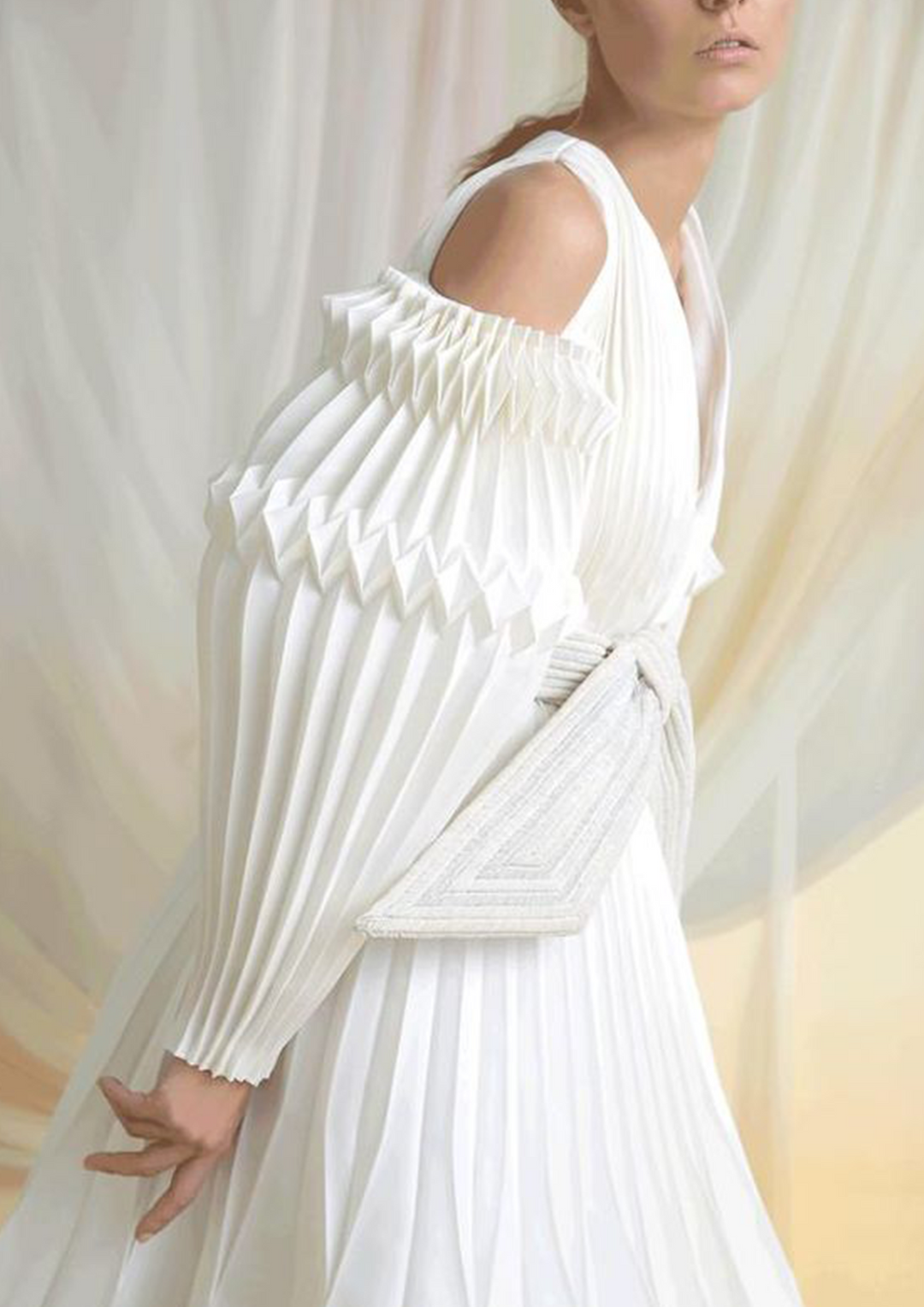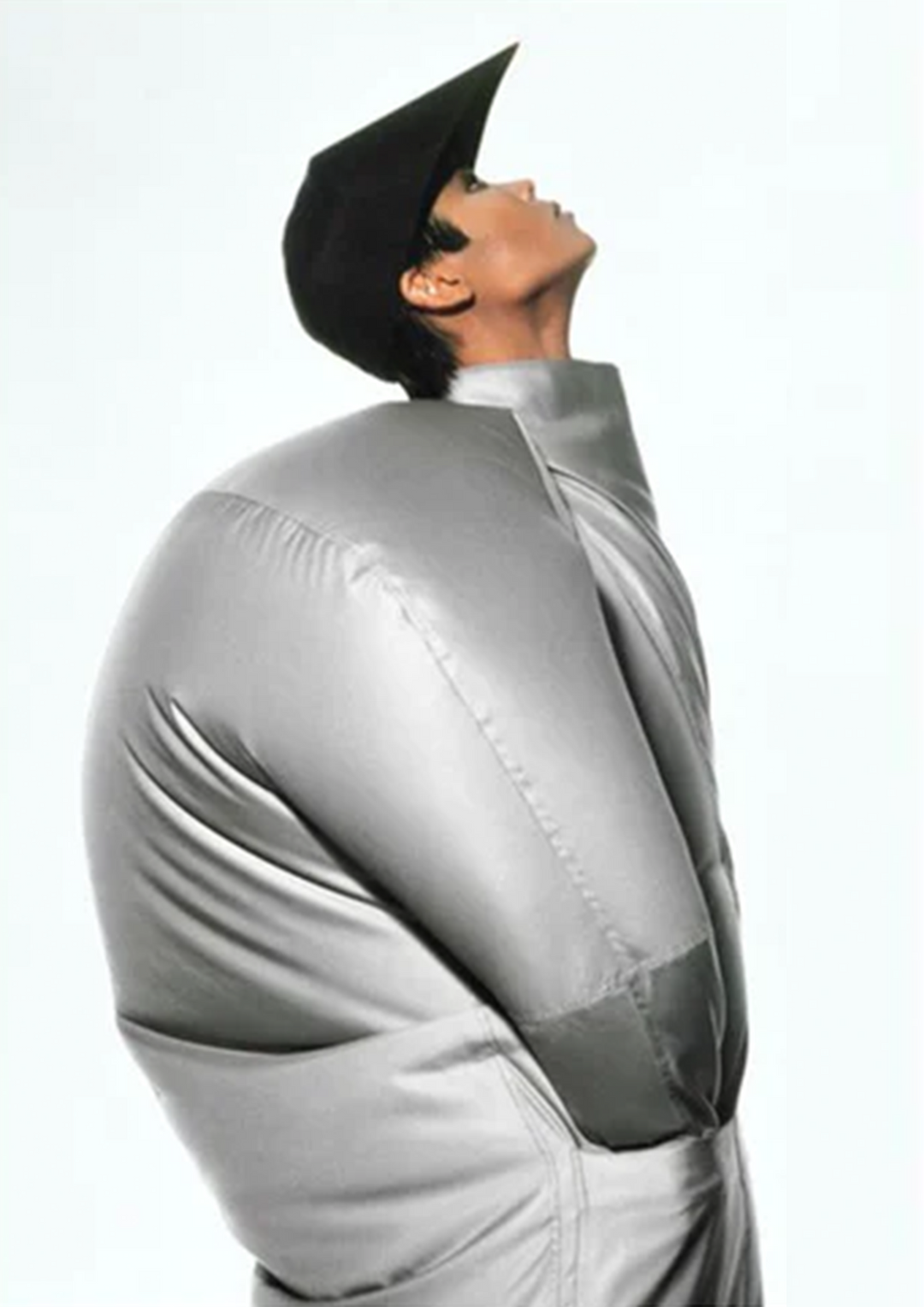Issey Miyake - on fashion and innovation
Issey Miyake was a famous, revolutionary and influential Japanese fashion designer known for his innovative and technologically groundbreaking designs. He is considered a fashion designer with a unique work that has not been seen before and even became one of the most prominent voices in the world of fashion starting from the 70s of the 20th century. Miyaki founded a fashion brand that gained international recognition and during his more than 50 years of creative work, he used to experiment with innovative techniques alongside traditional ones and combine them in his creation.

A dress from the Spring-Summer 1995 collection - made from 3D
How can you do without a little history?
Issey Miyake was born in April 1938 in Hiroshima, Japan and died in August 2022 at the age of 84 after suffering from liver cancer. He was only seven years old when the nuclear bomb was dropped on the city during World War II in 1945. He survived the bombing (which killed 140 thousand people!) but was left with a noticeable limp in his legs. Three years after the bombing, his mother died from radiation exposure. He did not talk about the issue in detail, but in 2009 he wrote an article about it in the "New York Times" in which he wrote that he did not want to be known as "a designer who survived the nuclear bombing."

As he grew up, he studied graphic design at Tama Art University in Tokyo and in 1964, at the age of 26, he graduated. Upon graduation, he moved to Paris, and enrolled in the Paris Haute Couture School (Chambra Syndicate de la Haute Couture Parisien) in Paris, from where he continued to work with renowned fashion designers such as Guy Laroche and Givenchy . After that he also lived for a short time in New York, where he worked with Jeffrey Bean, and in 1970 he returned to Tokyo and founded the Miyaki design studio. A short time later he opened a boutique store in Paris as well.
In the same decade his designs were exposed to the international fashion industry. His innovative works were presented in Paris for the first time, and he was the first Japanese designer to reveal his work internationally and the pioneer among the group of Japanese fashion designers who became famous in the West and went outside the borders of Japan, including: Kenzo Takeda, Yuji Yamamoto and Rei Kawakubo, owner of the Come de Gerson brand.

A model presents a dress from a collection "Pleats Please"
Paris RTW 1995
In 1970, he founded the design studio in Tokyo, the capital of Japan, and a year later exhibited for the first time in New York. In the 80s of the 20th century he was already recognized as one of the most innovative designers thanks to his extensive work combining innovative materials in clothing such as plastic alongside traditional Japanese materials and paper.

Issey Miyake's store in Paris
Miyaki developed close friendships with a number of artists and visionaries, such as with designer Ron Arad and even with Apple founder Steve Jobs - he designed the black golf knits he used to wear and which became identified with him.
Another fan of Issey Miyake was Zaha Hadid who liked to wear his clothes.
When he was a child, Issey Miyake dreamed of being an athlete, which explains the movement in his clothes and also in his fashion shows, which were a kind of dance show where the clothes were secondary actors.
The work of Issey Miyake
In the late 1980s, Issey Miyake began experimenting with new methods for creating fleece, with the goal of allowing flexibility for the wearer of the garment along with ease of washing the garment.
His experiments led him to develop a new fleece method in 1993: in which he first cut and sewed the garment, and only after that it was pressed between two layers of paper and compressed between hot steam vapors for the purpose of creating the fleece. Using this method, he created fleece clothes for the Frankfurt Ballet.

Issey Miyake's clothes, Frankfurt Ballet, 1993, Tokyo
(Photo: Kyoji Akiba)
It is impossible not to mention Felisa when talking about Issey Miyake. A few words about plissé : plissé is a word in the French language: Plissé , which means 'folds'. The term fleece refers to fabric that is woven or gathered into regular, multiple and uniform folds in the fabric . The fabric "remembers" and preserves the fleece even after it is removed from the paper pattern, from the fleece machine, or from the knitting machine - depending on the type of fabric from which the fleece is made.

A dress from the Pleats Please 2020 collection with pleated pleats
To make a fleece, make a template with the desired folds from two identical layers of cardboard. After that, open the two cardboard templates (that is, the pattern is not folded, but straight cardboard laid out on a table), spread the fabric between the two layers of cardboard, fasten the three layers together and fold them all together. After that, put the closed mold with the fabric trapped between the two layers of cardboard into the oven for a variable time, depending on the type of fabric and the complexity of the pattern. There are pleated fold patterns of various levels of complexity, with the most basic and popular pattern throughout history being the accordion pattern that resembles a fan fold.

The process of making the fleece, Atelier Gerard Lunion ( Ateliers Gérard Lognon), Paris, photo: Christian Polo ( Christian Poulot)
The fleece technique is one of the earliest techniques and was developed in ancient Egypt around 3000 BC. The Egyptians created the folds on the cloth using different patterns, and fixed the pattern using a heavy object made of metal. Throughout history, clothes and textiles were used as a source of protection for the body but not only - they were also used as a means of visual communication and expressed the status of the wearer. To differentiate between different fabrics and give them different meanings, different techniques were created to create volume, textures and unique details in the fabric. And from here the fleece developed.

The process of making fleece fabric: trapping the fabric between two layers of folded paper, Atelier Gerard Lognon
Issey Miyake's designs are recognizable from afar and are a combination of innovative techniques and ancient Japanese tradition. His fashion house has been kept at the forefront of international fashion brands for years and the name "Issey Miyake" was synonymous with quality, innovation and originality.
An example of Issey Miyake's technological innovation: a fabric developed at the fashion house in 2016 called Baked Stretch
and using glue baked in the oven so that a three-dimensional effect reminiscent of the folds of the fleece is created. The technique was developed through trial and error while changing the amount of glue and the baking temperature
For example, the collection he launched in 1993, which was an iconic collection from the Pleats Please line with light fleece clothes that cross sectors and ages and even cross seasons. Clothes made of polyester that can be washed in the machine, rolled in a suitcase and unpacked looking as fresh and springy as it looks before packing.

A dress from the Pleats Please collection
And if we're talking about innovation, isn't it that Miyaki created another artistic and design innovation already in 1998 in a joint project with the textile designer Dai Fujiwara, the former artistic director of the fashion house. The name of the project was A-POC (acronym for A Piece of Cloth ). With the technique they developed, the data of cut and size are entered into the computer, which are specially knitted or woven on a roll of fabric. After that, the garment can be cut directly from the roll, which saves fabric from falling off.

The end of the fashion show of the A-POC collection, Spring Summer 1999, Paris
Issey Miyake Fashion House : In 1994, the men's fashion design department passed to Naoki Takizawa, and 5 years later the women's fashion department also passed to him. Miyaki transferred these fields so that he could devote his full energy to research. In 2007, Naoki Takizawa became an independent designer in the Issey Miyake group, and Dai Fujiwara was appointed director of the Issey Miyake fashion house. Miyaki continued to supervise from the side all the collections he presented so far, while freeing himself up to develop other products and ideas, including his line of cosmetics and perfumes. The first perfume that was marketed L'eau d'Issey (Issey's water) was first marketed in 1992, and is a play on words because in French it sounds the same as the word "Odyssey". The bottle, designed by Miyaki, is based on the appearance of the moon behind the Eiffel Tower, as seen from Miyaki's apartment in Paris. This perfume is a success story that continues to be sold in large quantities ever since.

Issey Miyake's perfume bottle, L'Eau D'Issey
Miyake will forever be remembered as one of fashion's most innovative and prolific inventors. His true charm lies not only in his inexhaustible talent, but also in his humility in relation to his work and in being a pleasant and humble person: "I do things", he used to say simply - and did not exaggerate with big words about being such a great and talented fashion designer. His designs are designed for the modern needs of his customers. In 2016, as part of an interview with the British "Guardian" newspaper, one of his last interviews, he said: "In Paris, we call people who make clothes 'couturiers', designers who develop new items of clothing, but actually the work of design is to create something that works in real life. Design should offer a solution .'
ISSEY MIYAKE “Steam Stretch” Concept Movie from WOW inc. on Vimeo .
Want to hear me lecture?
For all the details: Liat Brendel Gilon, liatbrandel@gmail.com or 052-8128882







Leave a comment